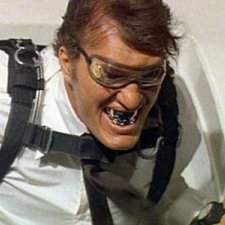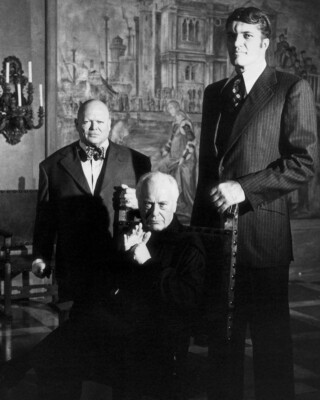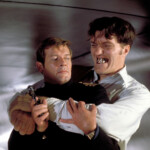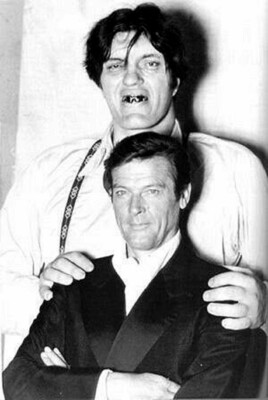 In 2014 the JBIFC was very sad to report the death of actor Richard Kiel, aged 74, on September 10 in California. Richard, of course, had played the very tall and steel-toothed henchman ‘Jaws’ in two hugely successful James Bond movies, The Spy Who Loved Me (1977) and Moonraker (1979), and he also later reprised the role in seven 007 videogames.
In 2014 the JBIFC was very sad to report the death of actor Richard Kiel, aged 74, on September 10 in California. Richard, of course, had played the very tall and steel-toothed henchman ‘Jaws’ in two hugely successful James Bond movies, The Spy Who Loved Me (1977) and Moonraker (1979), and he also later reprised the role in seven 007 videogames.
The late Sir Roger Moore, who had tweeted his response to the news as soon as he heard, said he was ‘distraught’ to hear about his friend’s passing, especially as they had been on the same BBC radio programme (The Reunion) just a week earlier.
Eight years after his passing, the JBIFC takes the opportunity to look back again at Kiel’s career and provide (00)7 points about his highly memorable contribution to the world of James Bond villainy.
001: Try Another Way.
After the end of his partnership with Harry Saltzman, in 1976-77 Albert ‘Cubby’ Broccoli was determined to make The Spy Who Loved Me, his first solo James Bond movie as producer, the biggest and the best 007 adventure so far. Although by no means a failure, it was felt that The Man With the Golden Gun (1974) had been rather lacklustre and rushed. With slightly more pre-production time available, there was now more of an opportunity to try and go back to the some of the classic elements of earlier Bond movies, and create something really special and iconic. Finding a distinctive and larger-than-life henchman to support the main villain Stromberg became a top priority. And, in casting Richard Kiel as ‘Jaws’, Broccoli and second-time Bond director Lewis Gilbert knew they had made an excellent choice. Jaws became very popular with cinema audiences worldwide; in fact, the character met with such approval from cinemagoers that it was almost inevitable that Kiel would return for a second ‘bite’ at the role.
002: Kiel’s Career.
Richard Kiel (1939-2014) was born in Detroit, Michigan, and made his screen debut in 1960 in an episode of the TV series Laramie. In between acting jobs in the early 1960s, he took jobs as a bouncer, a cemetery plot salesman, and even as a mathematics tutor at night classes. Kiel was not afraid to try whatever brought in the money, and – while there were times when he feared his size might be a hindrance rather than a help to his dreams of acting success – he was prepared to try whatever opportunity presented itself. He persevered with his acting career, and continued to appear in various TV programmes in the 1960s, including (ironically) two episodes of The Man From UNCLE (in 1964 and 1965). Other roles included appearances in The Twilight Zone, Gilligan’s Island, The Monkees, and The Wild, Wild West. He also took roles in various movies. His casting as ‘Jaws’ for Roger Moore’s third James Bond movie, however, brought the 7ft 2inch actor to worldwide fame (he was actually 7ft one-and-a-half inches, but he told people he was 7ft 2inches ‘because it was easier to remember’).
003: Creating a Baddie.
Production on the movie started in 1976. Albert ‘Cubby’ Broccoli was under considerable pressure to prove to the world that the Bond movies were still alive and kicking, and Cubby was very keen to cast very memorable support roles for the main actors. One key role was ‘Jaws’, the menacing enforcer and key assassin for Karl Stromberg, the main villain. The other henchman was Sandor, who would work alongside Jaws. Sandor was played by Milton Reid, a tough-looking former wrestler who had previously had a small role as a guard in Dr. No. The story is that an assistant had seen Richard Kiel in an episode of the American TV series The Barbary Coast and suggested him for the role of ‘Jaws’.

In a canny move, public awareness and curiosity about Kiel’s character was also raised when an early publicity still of Jaws, Sandor and Stromberg posing together at Pinewood was first released to UK newspapers in 1976 (see pic). This helped raise anticipation about the new Bond movie considerably.
Moreover, once principal photography was completed and post-production commenced, the ‘buzz’ around the coming Bond movie after what seemed like a longer period between films than usual was also reflected in some intriguing advance articles in film magazines. Realising how popular the role of Jaws was with test audiences for the film, and sensing that the movie was becoming very special indeed (it remained Sir Roger’s Moore’s favourite 007 movie), Bond producer Cubby Broccoli decided that, instead of dying in an inferno or being killed by a shark, Jaws should be seen swimming away in the final scenes of the movie. Broccoli said later that he liked the character played by Richard so much that ‘I wanted him to survive the shark so that we could use him in another Bond’. Although director Lewis Gilbert was not keen on the idea of a man biting a shark and surviving, Broccoli told him: ‘Man bites dog, Jaws bites shark. It’s perfect!’
As he worked with Kiel, Lewis Gilbert became more and more confident that Jaws would indeed beguile audiences. It was a sound judgement. As Gilbert later recalled in his memoirs, All My Flashbacks: ‘One of the biggest hits in the film was, of course, Jaws. The steel teeth that bit through anything gave him an identity that was immediate’.
Furthermore, in Gilbert’s estimation, the decision to make Jaws indestructible ‘really fixed him in audiences’ minds’. Despite being a baddie, there was something that still endeared him to audiences. As Gilbert observed, Jaws could fall off a roof or out of a car or have building works fall on top of him ‘and invariably he would extricate himself, dust himself off and walk away unscathed’. In the final scene with Jaws in the film, where he defied expectations that he had died and, instead, popped up and started swimming away, the audience at the UK premiere in July, 1977, broke into a round of applause.
004: Impact.
The film critic Alexander Walker, writing his review of the movie in the London Evening Standard, said Jaws ‘will be the hit of the film’, and noted the character’s resemblance to Boris Karloff’s monster. This was spot-on. Despite suffering considerable comfort problems from his specially-made steel teeth during production, the role of Jaws proved groundbreaking for Kiel’s acting career.

As Cubby Broccoli noted in his memoirs, When the Snow Melts, Jaws made Richard Kiel an immediate cult figure. He went on to chat shows around the world, and made TV viewers even more enthused. Sir Roger Moore, looking back on The Spy Who Loved Me in his 2008 memoirs My Word Is My Bond, recalled of Richard Kiel and his role as Jaws: ‘I can’t think of two more different characters – Richard is so kind, so gentle and indeed an accomplished writer as well as an actor, whereas Jaws is, well, a hired killer without much soul. Jaws did have a dry sense of humour, thanks to the little nuances Richard gave him’.
Another measure of Kiel’s impact is that the movie led to an increase in tourism to the pyramids in Egypt! A key and genuinely creepy sequence in the movie is set against the backdrop of a night-time light show at the pyramids (with the hauntingly loud voice of ex-Blofeld Charles Gray as narrator). In a tense chase, Jaws follows Fekesh into a tomb and bites him to death. This menacing scene appears to have not only frightened audiences, much to their delight, but galvanized the public’s interest in Eqypt as a tourist destination.
005: Return Another Day.
In fact, Kiel built up such a cult following that there were calls for Jaws to not only return but to go from Baddie to Goody (so to speak). Numerous letters were written by the public to the studios asking for Jaws to come back, and this arguably had a big influence on the plans for the next 007 movie. As Lewis Gilbert observed: ‘United Artists were so delighted with the film they wanted the next Bond picture right away. This was Moonraker and its chief novelty was, indeed, Jaws becoming a goody’. Interestingly, Broccoli’s original plan had been to film For Your Eyes Only, and this had indeed been announced as the next movie in the end credits of The Spy Who Loved Me. However, the smash-hit success of Star Wars in 1977 had caused Broccoli to rethink his plans and to capitalize on the renewed public interest in outer space.
In a first for the franchise, Kiel reprised his role and worked for his second main baddie, the ambitious and egotistical Sir Hugo Drax, whose hi-tech plans for outer space (like Stromberg’s plans for the sea) involved a radical wiping out of humanity for a fresh start. However, in a delicious plot twist, Jaws would come to realise (egged on by Bond) that Drax’s Nazi-like vision for a pure and ideal race had serious implications for a man like Jaws and his new girlfriend Dolly.
006: Blasting off.
Outer space and the about-turn of Jaws thus became two key elements in the new movie. In fact, such was the determination to meet popular audience demand, Richard Kiel even appeared in the truly breathtaking pre-credits to Moonraker, where Jaws pushes 007 out of a plane and there follows some brilliant parachute stunts. Kiel’s character was also given some welcome opportunities in the movie to be genuinely eerie again, such as when he appears in long shot in an alley during the carnival sequence in Rio de Janeiro.

However, not all critics were happy about the sequences with Jaws. Some argued the Jaws character had become wasted. John Brosnan, writing in the second edition of his classic book James Bond in the Cinema, argued that Jaws had become too much like a character in a Tom and Jerry cartoon, and also felt unease at the way Jaws had developed a love interest (Dolly) in the movie: ‘their scenes together were supposed to be amusingly touching but instead they are exercises in mawkish bathos that leave one writhing in embarrassment’. Ouch! In fact, Brosnan claimed that the treatment of Jaws exemplified a more general problem with Moonraker – the humour had been pushed too far, and at the expense of genuine tension and strong plotline. The jokey treatment of the Jaws character was, in Brosnan’s view, ‘an unfortunate error in judgement on the makers’ part’.
007: It’s Bond. And Beyond.
Yet, despite some of the unease expressed by critics, audiences still loved Moonraker. While Spy had boasted a budget of $13 million, an eye-watering $25 million was invested in the production of Moonraker, and every dollar shone out from the movie screen, ranging from the exotic locations, the stunning new technology (it was the public’s first real view of the new NASA space shuttles), and the fantastic set designs created by Ken Adam. It was a huge hit at the global box office, generating an estimated worldwide total of $203 million. And Kiel found himself still in great demand by interviewers and keen autograph-hunters. Perhaps this was also helped by the fact that a major U.S. toymaker produced twelve-inch dolls of the movie’s main characters, including one of Jaws. For many of his fans, an important surprise in the movie was that Jaws had been allowed to speak for the first time. This drew gasps of delight among cinema audiences.
Perhaps we should leave the last comments to the late, great Sir Roger Moore, who became a close pal of Kiel. Speaking in 2015, while engaged on his ‘An Evening with Roger Moore’ stage tour around the UK, the third 007 said of Richard Kiel: ‘He was a lovely man. I once asked him: “What question do people ask you that really drives you mad?” Richard answered: “How big were you when you were little?” He also hated those metal teeth and couldn’t wait to get them out after filming. It was very upsetting when he died’.
Did You Know?
Richard Kiel published his memoirs in 2002, entitled Making It Big in the Movies (with a foreword by Roger Moore), and he loved chatting to fans at film conventions and fairs around the world. One of his favourite stories concerned his fear of heights, something which often surprised fans. In the Egyptian sequences in The Spy Who Loved Me, Kiel insisted that a double of him was used for the scenes at the Karnak temple ruins where he stalks Bond and Anya from the scaffolding above; similarly, Kiel made it clear to Lewis Gilbert on Moonraker that he was determined a stunt-double was used for all his cable-car fight sequences. And who can blame him?

A rare Bond publicity still of Kiel and Moore
